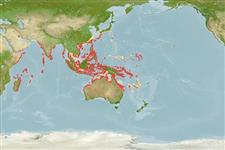Common names from other countries
Classification / Names / Names
आम नाम | उपशब्द | Catalog of Fishes (gen., sp.) | ITIS | CoL | WoRMS
Environment: milieu / climate zone / depth range / distribution range
पारिस्थितिकी
प्रवाल-भित्ति संयुक्त; गहराई सीमा 0 - 30 m (Ref. 98471). Subtropical; 36°N - 27°S, 43°E - 172°E (Ref. 848)
Indo-West Pacific: Yemen, Indonesia to Melanesia, north to Japan and south to Queensland, Australia.
Length at first maturity / आकार / वज़न / Age
Maturity: Lm ? range ? - ? cm
Formation: cerioid, with neat angular corallites up to 8 mm in diameter. Septa with 1 to 3 teeth. Mantle: thick and fleshy, usually covered with fine papillae. Color: gray, except in Japan where it is brick red or green (Ref. 848).
Occurs in protected reef environments and rocky foreshores (Ref. 848).
Life cycle and mating behavior
परिपक्व अवधि | पुनरुत्पत्ति | मछलीऔ का अंडे देना | अंडे | Fecundity | लार्वा
Members of the class Anthozoa are either gonochoric or hermaphroditic. Mature gametes are shed into the coelenteron and spawned through the mouth. Life cycle: The zygote develops into a planktonic planula larva. Metamorphosis begins with early morphogenesis of tentacles, septa and pharynx before larval settlement on the aboral end.
Veron, J.E.N. 2000. (Ref. 848)
IUCN Red List Status (Ref. 130435)
CITES status (Ref. 108899)
Not Evaluated
Human uses
| FishSource |
साधन
इंटरनेट स्रोत
Estimates based on models
Preferred temperature
(Ref.
115969): 25.4 - 29.3, mean 28.6 (based on 2925 cells).
Price category
Unknown.
